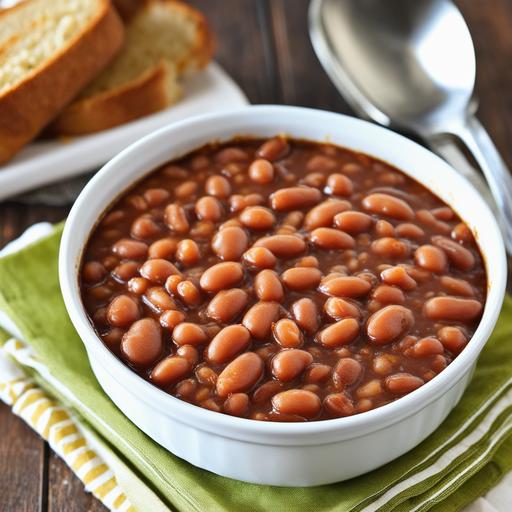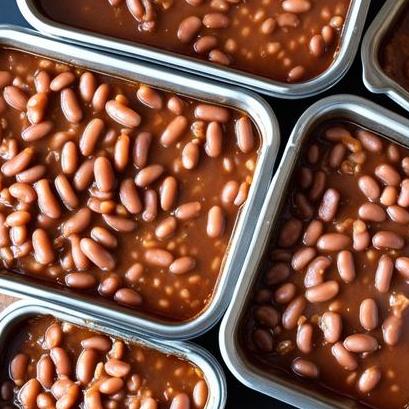
The Ultimate Guide To Baking Canned Baked Beans In The Oven
Baked beans are a classic comfort food that never fails to delight taste buds with its rich flavors and hearty texture. While the convenience of canned baked beans is undeniable, taking a few extra steps to elevate them in the oven can transform them into a mouthwatering dish that will have you coming back for seconds. In this comprehensive guide, we will delve into the food science behind baking canned baked beans in the oven, explore various culinary details, provide essential tips, suggest variations, and help you achieve the perfect level of doneness. So, let’s fire up the oven and learn how to create a truly memorable baked beans experience!
Food Science: Understanding the Magic
The process of baking canned baked beans can bring out flavors, enhance textures, and create a delightful, caramelized glaze. Understanding the food science behind it can help you unlock the true potential of this humble dish.
-
Caramelization: When cooked at higher temperatures, the sugars present in the beans and the added sauces undergo a process called caramelization. This gives baked beans their characteristic sweet and savory flavor and a beautiful golden-brown hue.
-
Reduction: Baking canned baked beans in the oven allows for some of the liquid to evaporate, resulting in a thicker, more concentrated sauce. This intensifies the flavors and promotes a velvety texture.
-
Flavor Infusion: As the beans bake, they absorb the aromas and flavors of the added ingredients, such as onions, spices, and bacon. The slow and even heat distribution in the oven ensures a well-incorporated combination of flavors.
Culinary Details: Selecting the Perfect Canned Baked Beans
Before we proceed, it is crucial to choose the right canned baked beans for the best possible outcome. While personal preferences vary, here are some key factors to consider while selecting your canned baked beans:
-
Brand and Quality: Opt for reputable brands known for their quality products. Read reviews or ask for recommendations from friends and family to ensure a satisfying choice.
-
Sauce Consistency: Determine if you prefer a thinner sauce or a thick, chunky one. Some brands offer a variety of textures, so choose based on your desired outcome.
-
Flavor Options: Explore different flavor profiles available in the market. Classic flavors include hickory, molasses, or the traditional Boston-style. Experiment with different combinations to find your favorite.
Cleaning and Preparation

Now that you have your canned baked beans ready, let’s move on to preparing them for the oven. Here’s a step-by-step guide to get you started:
-
Preheat the Oven: Set your oven to 350°F (175°C) to ensure proper cooking and even heat distribution.
-
Choose the Right Baking Dish: Select a baking dish that allows for even heat distribution. A shallow, oven-safe casserole dish or a Dutch oven works well.
-
Grease the Baking Dish: Lightly grease the baking dish to prevent the beans from sticking and to ensure easy cleanup later.
-
Pour the Canned Baked Beans: Open the can of baked beans and carefully pour them into the prepared baking dish. If you prefer, this is an excellent opportunity to add additional ingredients to enhance the flavor profile, such as a touch of maple syrup, mustard, or Worcestershire sauce.
Tips and Tricks for Elevating the Flavors

To take your canned baked beans to the next level, try incorporating these tips and tricks:
-
Add Aromatic Vegetables: Chop and sauté onions, bell peppers, or garlic for added depth and flavor. Cook them in a bit of oil until softened before mixing them into the canned baked beans.
-
Enhance the Smoke: While canned baked beans often have a smoky element, you can intensify it by adding cooked and crumbled bacon, smoked sausage, or even a dash of liquid smoke.
-
Sweeten the Deal: If you enjoy sweeter beans, experiment with adding a touch of brown sugar, maple syrup, or honey. Adjust the sweetness to your liking, keeping in mind that some brands might already have a sweet base.
-
Spice It Up: Rev up the flavor by incorporating your choice of spices or herbs. Try smoked paprika, chili powder, cumin, or thyme for an extra kick.
Achieving the Perfect Doneness

Determining the right level of doneness for your baked beans can be subjective, but there are several indicators to keep in mind:
-
Texture: Baked beans should have a creamy yet firm texture. They should not be mushy or overly dry. Keep an eye out for the desired consistency as the beans bake.
-
Color: The beans’ color should transition to a deep golden-brown, indicating caramelization and rich flavor development. Be patient and allow enough baking time to achieve this transformative color.
-
Sauce Thickness: The sauce should have reduced and thickened, coating the beans evenly. If you prefer a saucier outcome, avoid overcooking, as the sauce may dry up.
Recipe: Baking Canned Baked Beans in the Oven

Now that you’re equipped with the knowledge and techniques, it’s time to bring all the elements together and create a scrumptious batch of baked beans. Here’s a basic recipe to get you started:
Ingredients:
-
2 cans (28 ounces each) of your favorite canned baked beans
-
1 medium onion, diced
-
4 slices of bacon, cooked and crumbled
-
2 tablespoons of brown sugar
-
1 tablespoon of Worcestershire sauce
-
1 tablespoon of mustard (optional)
-
Salt and pepper to taste
Instructions:
-
Preheat your oven to 350°F (175°C).
-
Grease a baking dish or Dutch oven to prevent sticking.
-
In a separate pan, sauté the diced onions until translucent.
-
Place the canned baked beans in the prepared baking dish.
-
Add the sautéed onions, cooked bacon, brown sugar, Worcestershire sauce, and mustard (if using) to the beans.
-
Season with salt and pepper to taste.
-
Stir gently to combine all the ingredients.
-
Cover the dish with aluminum foil or a lid to retain moisture.
-
Place the dish in the preheated oven and bake for approximately 45 minutes to an hour, or until the beans reach the desired level of doneness.
-
Remove the dish from the oven and let it rest for a few minutes before serving.
Overcooking and Undercooking: Finding the Sweet Spot
While achieving the perfect doneness is the goal, it’s essential to understand the consequences of overcooking or undercooking your baked beans:
-
Overcooking: Overbaking can result in dry, tough beans and a thick sauce that might lose its appeal. Avoid excessive baking time, particularly if you prefer a saucier outcome.
-
Undercooking: On the other hand, underbaking your beans can lead to uncooked or crunchy beans, while the sauce might lack a rich, caramelized flavor. Ensure the beans have a creamy yet firm texture before removing them from the oven.
Variations: Unleashing Your Creativity
Now that you have mastered the basic recipe, feel free to experiment with the following variations to tailor your baked beans to specific tastes or preferences:
-
Vegetarian Twist: Substitute the bacon with smoked tofu or veggie bacon to create a vegetarian-friendly version without compromising on flavor.
-
Spicy Sensation: Add diced jalapenos, chipotle peppers, or a pinch of cayenne powder to turn up the heat and create a fiery variation.
-
Meat Lover’s Delight: Amp up the protein by incorporating diced ham, ground beef, or shredded chicken for an extra meaty experience.
-
Cheesy Bliss: Sprinkle grated cheddar or a melting cheese of your choice over the beans during the last five minutes of baking for a gooey delight.
Conclusion
Baking canned baked beans in the oven is a delightful culinary adventure that can transform a simple pantry staple into a delectable dish bursting with flavors. Armed with knowledge of food science, culinary details, preparation tips, and various options for customization and variations, you are now ready to create your own masterpiece. So next time you reach for that can of baked beans, dare to take it a step further, fire up the oven, and let the magic unfold. Enjoy your journey to baked beans perfection!
Sources
FAQS On Canned Baked Beans Oven Recipe
What Ingredients Are Needed For Making Canned Baked Beans In The Oven?
To make canned baked beans in the oven, you will need a can of baked beans (of your choice), some chopped onions, sliced bacon, brown sugar, ketchup, and Worcestershire sauce.
How Long Does It Take To Cook Canned Baked Beans In The Oven?
Typically, canned baked beans take around 20-25 minutes to cook in the oven at a temperature of 375°F. However, cooking time may vary depending on your oven and the recipe you follow. It’s recommended to check the progress of your beans after ten minutes of cooking and stir them occasionally.
Can I Add Any Other Ingredients To My Canned Baked Beans Oven Recipe?
Yes, you can add other ingredients of your choice to your baked beans recipe. You can add chopped bell peppers, garlic, hot sauce, honey mustard, or any spices you like. However, make sure not to add too many ingredients that might overpower the original taste of baked beans.
Can I Make Vegan Canned Baked Beans In The Oven?
Yes, you can make vegan canned baked beans in the oven by choosing a can of vegetarian or vegan baked beans. Additionally, you can use vegan bacon substitutes or omit them entirely and add extra veggies such as mushrooms or zucchini.
How Can I Store Leftover Canned Baked Beans Made In The Oven?
You can store leftover canned baked beans made in the oven in an airtight container in the refrigerator for up to three days. When reheating the baked beans, you can add a little water or broth to prevent them from drying out. Alternatively, you can freeze them for up to three months. Make sure to thaw them overnight in the refrigerator before reheating.



